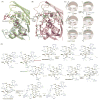Radical Breakthroughs in Natural Product and Cofactor Biosynthesis
- PMID: 29072833
- PMCID: PMC5790616
- DOI: 10.1021/acs.biochem.7b00878
Radical Breakthroughs in Natural Product and Cofactor Biosynthesis
Abstract
The radical SAM (S-adenosyl-l-methionine) superfamily is one of the largest group of enzymes with >113000 annotated sequences [Landgraf, B. J., et al. (2016) Annu. Rev. Biochem. 85, 485-514]. Members of this superfamily catalyze the reductive cleavage of SAM using an oxygen sensitive 4Fe-4S cluster to transiently generate 5'-deoxyadenosyl radical that is subsequently used to initiate diverse free radical-mediated reactions. Because of the unique reactivity of free radicals, radical SAM enzymes frequently catalyze chemically challenging reactions critical for the biosynthesis of unique structures of cofactors and natural products. In this Perspective, I will discuss the impact of characterizing novel functions in radical SAM enzymes on our understanding of biosynthetic pathways and use two recent examples from my own group with a particular emphasis on two radical SAM enzymes that are responsible for carbon skeleton formation during the biosynthesis of a cofactor and natural products.
Figures







References
-
- Landgraf BJ, McCarthy EL, Booker SJ. Radical S-Adenosylmethionine Enzymes in Human Health and Disease. Annu Rev Biochem. 2016;85:485–514. - PubMed
-
- Mendel RR, Schwarz G. Molybdenum cofactor biosynthesis in plants and humans. Coord Chem Rev. 2011;255:1145–1158.
-
- Schwarz G, Mendel RR, Ribbe MW. Molybdenum cofactors, enzymes and pathways. Nature. 2009;460(7257):839–47. - PubMed
Publication types
MeSH terms
Substances
Grants and funding
LinkOut - more resources
Full Text Sources
Other Literature Sources
Molecular Biology Databases

